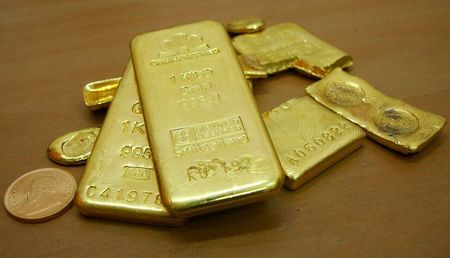By Peter Hobson
LONDON (Reuters) – A group of banks, financial firms and blue-chip companies has drawn up trading guidelines designed to boost activity in the auctions that set gold and silver benchmark prices used around the world and make them more reliable.
The benchmarks are intended to be a fair and accurate snapshot of the fast-moving spot market. But they sometimes diverge from the spot price, leaving buyers and sellers with unexpected gains or losses.
On Oct. 29, for example, the afternoon gold benchmark was set at $1,769.15, $1.95 below the lowest level reached on the spot market that day, data from Refinitiv Eikon shows — costing sellers money and gifting buyers a bargain.
Jewellers, miners, traders and manufacturers across the globe buy and sell gold worth hundreds of millions of dollars each day at the benchmark auctions. The benchmark prices are also embedded in supply contracts across the industry.
Large divergences have become rare but are caused in part by a more recent unwillingness among banks who feed client orders into the auctions to add or remove buy or sell orders to ensure the auctions stay close to prices in the spot market.
After scandals over the fixing of benchmarks such as LIBOR, many feared regulators could see it as price manipulation.
The Fixed Income, Currencies and Commodities Markets Standards Board (FMSB) – a group of large banks, asset managers and other companies that says it aims make markets more transparent, fair and effective – has drafted a “standard” explaining when it is appropriate for banks to change orders during the auctions.
It says: “This Standard is designed to provide some clarity … so as to increase the volume of bids and offers submitted to LBMA (benchmark) Auctions and improve the quality of price discovery resulting from them.”
The FMSB, which has no regulatory authority, said it aimed to publish the final standard in December.
The gold https://www.reuters.com/article/us-gold-benchmark-idUSKBN18K2H6 and silver https://www.reuters.com/article/us-silver-benchmark-exclusive-idUSKBN17T1XS benchmarks suffered numerous large divergences around 2016 and 2017, when as few as ten firms — nine of them banks — participated in the gold auctions and seven — all banks — took part in the silver auctions.
Eighteen participants now funnel orders to the gold auctions, eight of which are not banks but other trading companies. Fifteen firms take part in the silver auctions, eight of which are not banks.
“I don’t think it’s much of an issue anymore,” said an executive at a large bank involved in the benchmarks. But he said his bank could begin trading the auctions more flexibly and others may do the same, improving liquidity.
The gold and silver benchmarks are operated by ICE Benchmark Administration (IBA), a unit of Intercontinental Exchange (ICE), on behalf of the London Bullion Market Association (LBMA), a trade association.
“LBMA, IBA and market participants are satisfied that currently there is ample ongoing liquidity to ensure that all precious metals auctions continue to function well,” they said.
The participants in the gold benchmark are Bank of China, Bank of Communications, Citibank, Coins ‘N Things, DRW Investments, ED&F Man, Goldman Sachs, HSBC, Industrial and Commercial Bank of China (ICBC), Jane Street, JPMorgan, Koch Supply and Trading, Koch Commodities Europe, Marex Spectron, Morgan Stanley, Standard Chartered, StoneX and TD Bank.
Marex said it was satisfied with liquidity but would welcome any increase. The others declined to comment or did not respond to requests for comment.
The FMSB guidelines also apply to the platinum and palladium price benchmarks set in daily auctions run by the London Metal Exchange. The LME said it was “entirely satisfied” with the benchmarks but welcomed the FMSB standard.
(Reporting by Peter Hobson; Editing by Kirsten Donovan)











